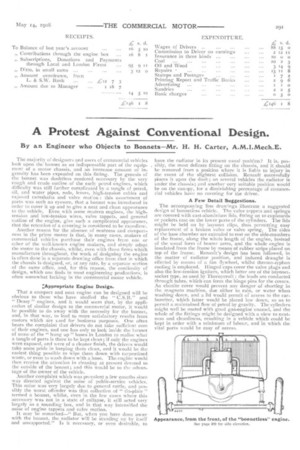A Protest Against Conventional Design.
Page 19

If you've noticed an error in this article please click here to report it so we can fix it.
By an Engineer who Objects to Bonnets—Mr. H. H. Carter, A.M.I.Mech.E.
The majority of designers and users of commercial vehicles look upon the bonnet as an indispensable part of the equipment of a motor chassis, and an immense amount of ingenuity has been expended on this fitting. The genesis of the bonnet was doubtless rendered necessary by the very rough and crude outline of the early petrol engines, which difficulty was still further complicated by a tangle of petrol, oil, and water pipes, rods, levers, high-tension cables and exposed camshafts and valve motion : this assortment of parts was such an eyesore, that a bonnet was introduced in order to cover it up and to give a neat and clean appearance to the vehicle. Even with some modern engines, the hightension and low-tension wires, valve tappets, and general outline of the engine, give such a complicated appearance, that the retention of a covering is considered to be expedient.
Another reason for the absence of neatness and compactness in the prime mover is that, in many cases, makers of commercial vehicles purchase their engines from one or other of the well-known engine makers, and simply adapt the motor to the chassis, whilst, even with those firms which manufacture throughout, the work of designing the engine is often done in a separate drawing office from that in which the chassis is designed, or, at any rate, by a separate section of the same office, and, for this reason, the continuity of design, which one finds in most engineering productions, is often somewhat lacking in the commercial motor vehicle.
Appropriate Engine Design.
That a compact and neat engine can be designed will be obvious to those who have studied the " C.S.B." and " Deasy " engines, and it would seem that, by the application of similar design to the commercial motor, it would be possible to do away with the necessity for the bonnet, and, in that way, to lead to more satisfactory results from motors which are esed for buiiness purposes. One often hears the complaint that drivers do not take sufficient care of their engines, and one has only to look inside the bonnet of sonic of the " hung up " buses in London to realise what a tangle of parts is there to be kept clean; if only the engines were exposed, and were of a cleaner finish, the drivers would take some pride in keeping theM clean, and it would be the easiest thing possible to wipe them down with turpentined waste, or even to wash down with a hose. The engine would then receive the attention in cleaning at present devoted to the outside of the bonnet ; and this would be to the advantage of the owner of the vehicle.
Another complaint which was prevalent a few months since was directed against the noise of public-service vehicles. This noise was very largely due to general rattle, and possibly the worst offender was that collection of " tin-plate " termed a bonnet, whilst, even in the few cases where this accessory was not in a state of collapse, it still acted very largely as a sounding box, and in that way intensified the noise of engine tappets and valve motion.
It may be remarked—" But, when you. have done away with the bonnet, the radiator will be standing up by itself and unsupported." Is it necessary, or even desirable, to have the radiator in its present usual position? It is, possibly, the most delicate fitting on the chassis, and it should be removed from a position where it is liable to injury in the event of the slightest collision. Renault successfully places it upon the dash ; on several vehicles the radiator is under the chassis; .and another very suitable position would be on the canopy, for a diminishing percentage of commercial vehicles have no covering for the driver.
A Few Detail Suggestions.
The accompanying line drawings illustrate a suggested design of bonnetless vehicle. The valve tappets and springs are covered with cast-aluminium lids, fitting on to cupboards or pockets cast on the lower parts of the cylinders. The lids might be held on by bayonet clips, thus permitting easy replacement of a broken valve or valve spring. The sides of the base chamber are extended to rest on the side-members of the frame, along the whole length of the engine, instead of the usual form of bearer arms, and the whole engine is insulated from the frame by means of rubber strips placed on top of the frame. Renault's design has been followed, in the matter of radiator position, and induced draught is effected by means of a fan flywheel, whilst thermo-syphon cooling is employed. Hinged caps cover the valve plugs and also the low-tension igniters, which latter are of the bayonetsocket type, as used by Thornycroft : the leads are conducted through tubes, which can form the hinge pins for the covers. An ebonite cover would prevent any danger of shorting in the magneto machine, due either to rain, or water when washing down, and a lid would permit of access to the carburetter, which latter would be placed low down, so as to permit a maintained flow of petrol by gravity. The cylinders might well be coated with good gas-engine enamel, and the whole of the fittings might be designed with a view to neatness and cleanliness, resulting in a vehicle which could be kept in order with a minimum of labour, and in which the vital parts would be easy of access.




















